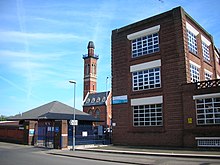Birmingham Corporation Water Department

Birmingham Waterworks Tower by John Henry Chamberlain
|
|
| Predecessor | Birmingham Waterworks Company |
|---|---|
| Successor | Severn Trent Water Authority |
| Formation | 1876 |
| Extinction | 1974 |
| Location | |
|
Region served
|
City of Birmingham |
|
Parent organization
|
Birmingham City Council |
The Birmingham Corporation Water Department was responsible for the supply of water to Birmingham, England, from 1876 to 1974. It was also known as Birmingham Corporation Waterworks Department.
The earliest formal supply of water was offered by the Birmingham Waterworks Company. In 1808 notice of a Bill was given in Parliament for a scheme to provide Birmingham with an organised supply of water. It was opposed, and in 1809 a meeting considered the proposal, appointed a committee, and rejected the idea of the waterworks. A second Bill was rejected in 1811. It was not until 1826 that Parliament granted powers constituting
the Company of Proprietors of the Birmingham Waterworks for the purpose of providing a sufficient and constant supply of good and wholesome water for domestic, manufacturing and other purposes
The area to be supplied used only the River Tame. The initial supply was intermittent. In 1849, the Corporation made agreement with the Company for a constant supply in certain districts. By 1853 a constant supply was universal.
The Grade II listed Birmingham Waterworks Tower at Edgbaston Waterworks was designed by John Henry Chamberlain and built in 1870. There is no connection to Edgbaston Reservoir, built to feed local canals, a hundred years previously.
By 1873 the total quantity supplied was around 3,000 million imperial gallons (14,000,000 m3) per annum.
The Birmingham Corporation Act of 1875 empowered Birmingham Corporation to purchase the Birmingham Waterworks Company. The transaction was supervised by the Mayor of Birmingham, Joseph Chamberlain, and completed on 1 January 1876 for the sum of £1,350,000 (equivalent to £114,527,150 in 2015). Chamberlain declared to a House of Commons committee
We have not the slightest intention of making profit...We shall get our profit indirectly in the comfort of the town and in the health of the inhabitants
The rivers Bourne and Blythe, Plant's Brook and Perry Stream were used as sources. The corporation dug six wells at Aston, Short Heath, King's Vale, Perry Barr, Selly Oak (Selly Oak Pumping Station survives), and Longbridge. These provided 20 million imperial gallons (91,000 m3) per day. There were 14 reservoirs (including Perry Barr, Witton Lakes and Brookvale) with a total capacity of 628.5 million imperial gallons (2,857,000 m3).
...
Wikipedia
